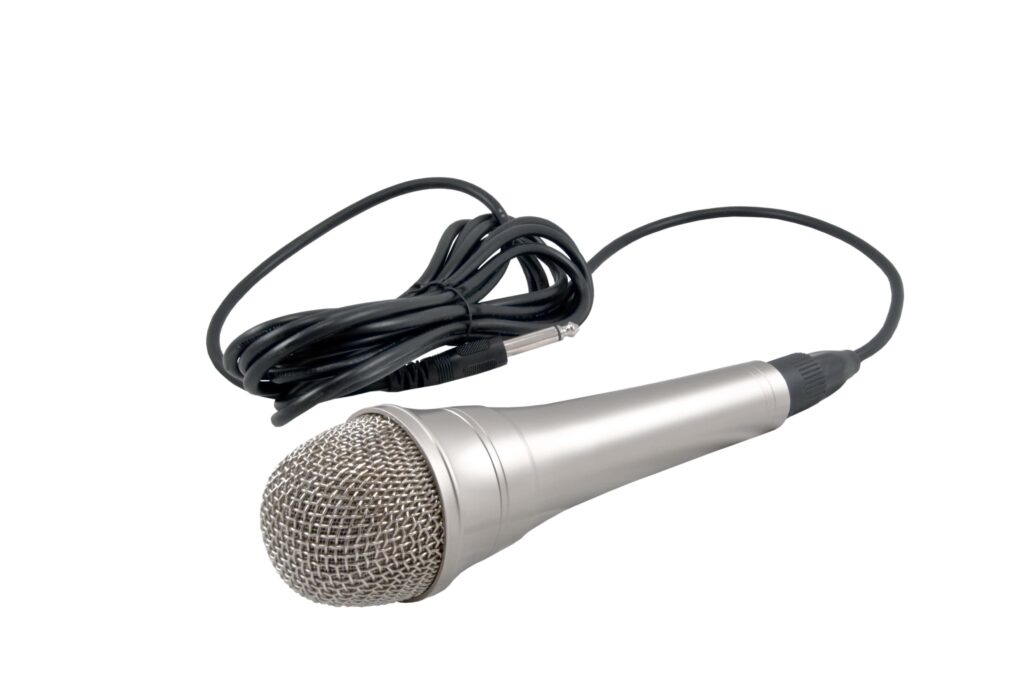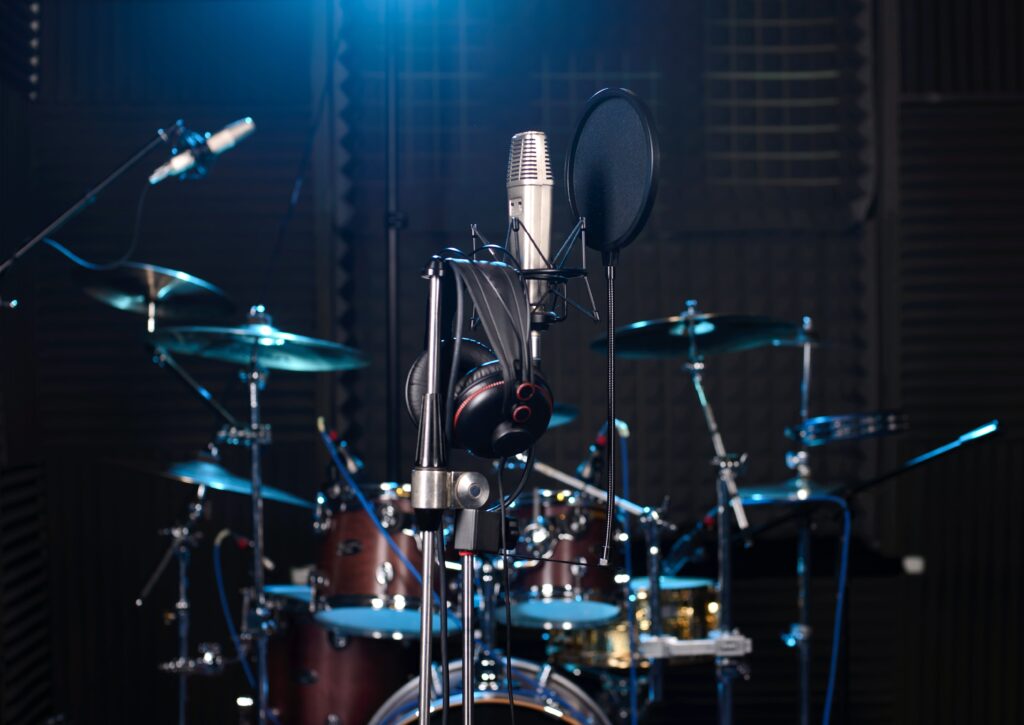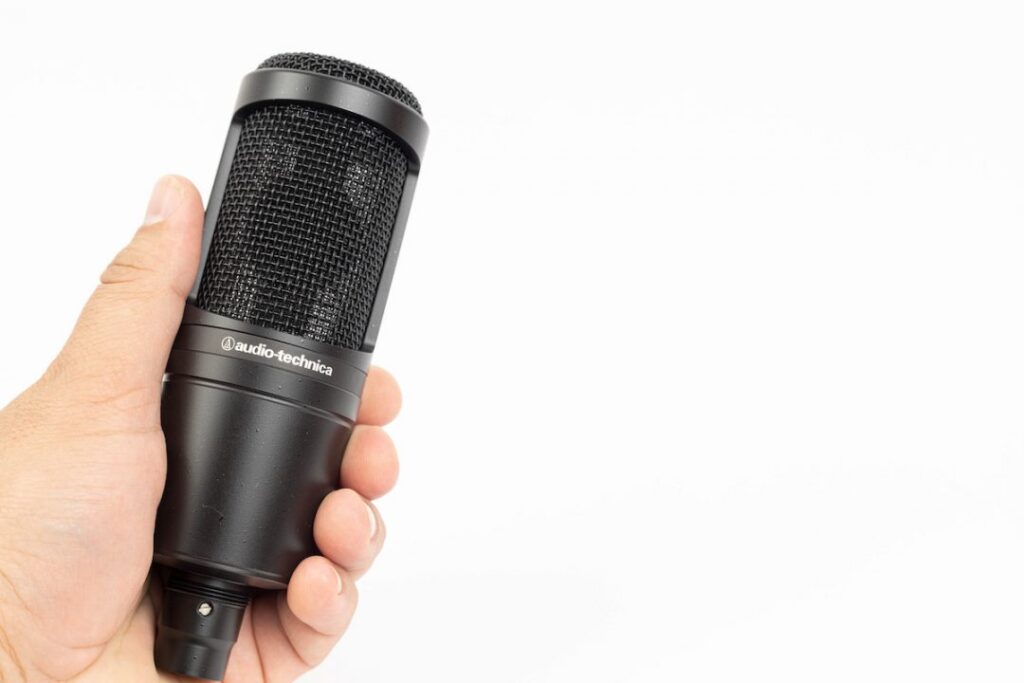The hypercardioid pattern is related to the well-known cardioid polar pattern, but it is often misunderstood and confused with the supercardioid pattern. If you know about hypercardioid polar patterns and how to use them best, you will be more effective on stage and in the studio.
A hypercardioid microphone is similar to a cardioid microphone, but it has a slightly larger figure-8 contribution. This makes the sensitive area in front of the microphone smaller and the sensitive area in the back.
The hypercardioid Microphone polar/pickup pattern of a hypercardioid microphone is very. It is most sensitive to sounds on-axis or where the mic “points.” It has null points at 110° and 250° and a sensitivity lobe in the back. Due to their high directionality, hypercardioid mics are often used in the film Industry.
Types of Hypercardioid Microphones
Hypercardioid microphones, a specialized type of microphone, come in two main varieties: condenser and dynamic microphones. Understanding the nuances of each class is crucial for audio professionals and enthusiasts alike.
Hypercardioid Condenser Microphones
Condenser microphones are well known for their comprehensive frequency response and sensitivity. A hypercardioid condenser microphone operates on the same principle. These microphones use an electrically charged diaphragm placed very close to a backplate. This design results in exceptional sensitivity, making them ideal for capturing subtle sounds with great detail.
The benefits of hypercardioid condenser microphones are vast. Their precise pickup pattern focuses on the sound directly in front while minimizing background noise. This characteristic makes them invaluable in studio settings, especially for recording vocals and acoustic instruments. Musicians appreciate these microphones for their ability to faithfully capture the nuances of their performances.
Hypercardioid Dynamic Microphones:
Dynamic microphones, on the other hand, work on electromagnetic induction. When sound waves hit the diaphragm attached to a coil of wire within a magnetic field, an electric current generates the audio signal. Hypercardioid dynamic microphones offer the advantage of robustness and durability. They can handle high sound pressure levels, making them ideal for live performances, especially in loud environments like concerts and sporting events.
The specific uses of hypercardioid dynamic microphones are diverse. Sound engineers often rely on them for miking guitar amplifiers because they can withstand high volumes without distortion. Additionally, these microphones are popular among broadcasters and podcasters, ensuring clear and focused voice recordings even in noisy surroundings.
Polar Patterns of Hypercardioid Microphone
The hypercardioid polar pattern, like the closely related supercardioid pattern, is a more directional version of the standard cardioid pattern.
The increased directionality and side rejection of hypercardioid comes at the cost of a very sensitive back lobe.
The hypercardioid pattern reminds me of a combination between the standard cardioid pattern and the bidirectional polar pattern. When we think of it as a superposition, we have a bidirectional pattern with a smaller rear lobe and null points that are farther back than they would be without the cardioid pattern on top.
The pickup polarity of the cardioid is always positive, while that of the bidirectional is positive in front and negative in the back.
Putting the two rids of the cardioid’s rear null point on top of each other and replacing it with a sensitive lobe. It also moves the side null points of the two-way pattern (at 110° and 250°) toward the back. The result would be like the hypercardioid pattern!
Applications and Uses of Hypercardioid Microphones:
Hypercardioid microphones, with their precise polar pattern, find extensive applications across diverse audio environments, making them indispensable tools for professionals in various fields.
Audio Recording and Studio Applications:
In the controlled environment of a studio, hypercardioid microphones shine. They are favored for their ability to capture sound from a single direction while minimizing unwanted ambient noise. This characteristic is especially crucial for recording delicate acoustic instruments and vocals where capturing nuances is paramount. Engineers often rely on hypercardioid condenser microphones for these applications, ensuring detailed, high-quality recordings that form the backbone of music albums and soundtracks.
Live Sound and Stage Performances:
In the realm of live sound, hypercardioid microphones are workhorses. Their focused pickup pattern helps isolate specific sound sources on stage, preventing feedback and minimizing the impact of nearby stage noise. Hypercardioid dynamic microphones are frequently used for miking instruments and vocals during live performances. They ensure the audience hears a clear, well-defined sound even amid a cacophony, enhancing the overall live music experience.
Film and Television Production:
Hypercardioid microphones are invaluable in film and television production, especially for boom miking. Their ability to capture targeted dialogue or specific sounds amidst a busy set or noisy background is crucial for high-quality audio in movies, TV shows, and documentaries. Film crews often use hyper cardioid microphones on boom poles to focus on actors’ dialogue while minimizing surrounding noise, ensuring seamless audio integration with the visuals.
Podcasting and Streaming:
In the digital age, hypercardioid microphones have been significant in podcasting and streaming setups. Podcasters and streamers appreciate these microphones for capturing clear, professional-grade audio even in home environments. The focused pickup pattern ensures the host’s voice is captured crisply while reducing interference from room echoes and ambient noises. This enhances the overall production quality, making podcasts and streams more engaging for listeners and viewers.
Field Recording and Outdoor Applications:
For sound engineers and nature enthusiasts engaged in field recording, hypercardioid microphones are essential companions. Their ability to isolate specific sounds in noisy outdoor environments makes them ideal for capturing wildlife sounds, natural phenomena, and ambient audio for documentaries and soundscapes. The focused pickup pattern ensures that the desired sounds are captured accurately while minimizing wind and environmental noise, preserving the authenticity of the recordings.
Tips for Choosing and Using Hypercardioid Microphones:
Factors to Consider when Selecting a Hypercardioid Microphone
When selecting a hypercardioid microphone, several factors come into play. First and foremost, consider the microphone’s intended use. A hypercardioid condenser microphone might be ideal for studio applications due to its sensitivity and detailed sound capture. A hypercardioid dynamic microphone’s durability and ability to handle high sound pressure levels make it a practical choice for live performances. Additionally, assess the microphone’s frequency response to ensure it complements the specific sound source you’re recording. Budget is crucial; fortunately, options cater to various price ranges, guaranteeing quality within your financial scope.
Proper Techniques for Using Hypercardioid Microphones Effectively:
Using a hypercardioid microphone effectively requires understanding its directional properties. Position the microphone precisely before the sound source to capture the cleanest signal while minimizing background noise. Proper microphone placement is crucial; experiment with angles and distances to find the sweet spot. Investing in a quality shock mount and pop filter is essential to reduce handling noise and plosive sounds, respectively. Additionally, using a windscreen outdoors can mitigate wind noise, ensuring clear recordings in challenging conditions.
Common Mistakes to Avoid during Microphone Setup and Usage:
One common mistake is improper gain staging. Set the microphone’s gain levels appropriately to prevent distortion and ensure a clean signal. Not place the microphone to close to source of sound, which can result in overwhelming levels and distortion. Failing to test the microphone in the specific environment before a critical recording can lead to unexpected issues, so always conduct sound checks beforehand. Another area for improvement is proper storage and maintenance. Hypercardioid microphones are precision instruments; store them in a protective case and clean them regularly to maintain optimal performance over time.
Important Factors about Hypercardioid Microphone
- Since hypercardioid mics are so focused, they need an even more precise mic technique than supercardioid mics. If a singer moves off-axis, the mic will not work well, affecting the sound quality. In other words, the singer should ensure that the microphone is pointed at their mouth.
- As with supercardioid mics, a microphone’s sensitivity to sound coming from behind is affected by how well it can pick up sound from the front. While a cardioid pattern is least sensitive at the back (180 degrees off-axis), a supercardioid mic is least sensitive at 125 degrees, and a hypercardioid mic is least sensitive at 110 degrees. When placing stage wedges, you will need to keep this in mind.
- Also, the back of a hypercardioid mic is more sensitive than the back of a supercardioid mic. This means that you need to pay extra attention to any sound coming from in front of the singer or sound source.
- There is a worry that too much proximity affects many hypercardioid mics.
Conclusion
In this comprehensive exploration of hypercardioid microphones, we’ve delved into their two main types: condenser and dynamic. Condenser hypercardioid microphones, known for their sensitivity and detailed sound capture, excel in controlled studio environments, making them ideal for recording delicate instruments and vocals. On the other hand, hypercardioid dynamic microphones, prized for their durability and ability to handle high sound pressure levels, are invaluable in live performances and outdoor settings, providing clear sound even amidst noise.
The article emphasized the critical factors when selecting a hypercardioid microphone. Tailoring the choice to the specific application, understanding directional properties, and proper placement techniques are vital for practical use. Additionally, avoiding common mistakes like improper gain staging and neglecting maintenance ensures optimal performance over time.
Versatility and Importance of Hypercardioid Microphones:
Hypercardioid microphones stand out due to their focused pickup patterns, making them essential in various audio applications. Whether in studios for detailed recordings, on stages for live performances, or in outdoor environments for field recording, hypercardioid microphones play a pivotal role in capturing clear and focused sound while minimizing unwanted noise. Their adaptability across different settings showcases their versatility, making them indispensable tools for audio professionals and enthusiasts.
When Should You Use A Hypercardioid Microphone?
where to use a hypercardioid microphone?
In front of two live sound reinforcement foldback monitoring systems (ensuring the monitors are at the hypercardioid null points).
To record certain sounds in a certain place.
To close the mic in noisy places and pick out individual sound sources.
To pick up sounds from sources that are close together (like the drums of a drum kit).




